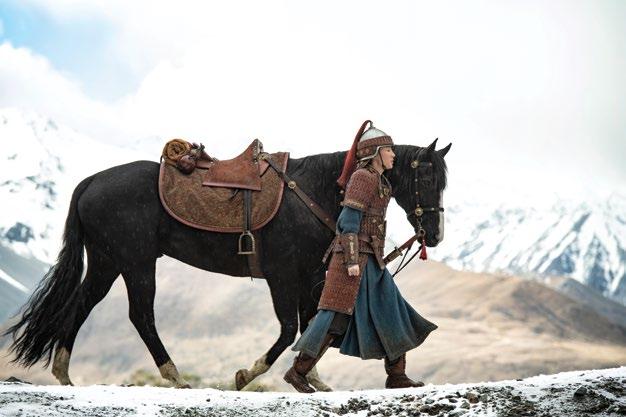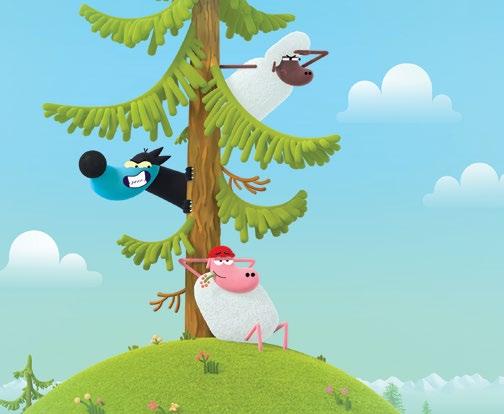
6 minute read
Building the Saga of a True Warrior
VFX supervisor Sean Andrew Faden reveals some of the digital tricks of the new live-action Mulan.
Niki Caro’s recent live-action re-imagining of 1998 Disney animated classic Mulan — inspired by the centuries-old epic poem about the Chinese warrior princess — unfolds against stunning natural landscapes and beautiful historic monuments. Many of the breath-taking images showcased in this 116-minute epic are in fact the result of the close collaboration between the director, the flm’s director of photography Mandy Walker and seasoned visual effect supervisor Sean Andrew Faden (Fast & Furious 6, Game of Thrones, Captain America: First Avenger). With close to 1,600 classic VFX shots, this new version of Mulan used the services of four primary vendors: Framestore, Weta Digital, Sony Pictures Imageworks and Image Engine, as well as some additional work by Crafty Apes. “When I frst joined the project in the spring of 2017, I was really excited by the scope of the project with all these incredible locations,” says Faden. “I knew it was going to be big. Most of our locations were shot in New Zealand, mainly in the Ahuriri Valley and the Kumeu Film Studios in Auckland, and the second unit and plate unit were done in China for about six weeks. The end result of what you see in the movie is a combination of New Zealand plates with Chinese favors, mountains and beautiful skies.”
Faden says he knew that the avalanche sequence and the battle sequences were going to be challenging, but he’s very pleased with the way they turned out. “We had to help Niki achieve her vision of this epic tale,” he explains. “But we had to be careful about how explicit the visuals for the battle footage had to be since we were making the flm for a family audience. We had about 900 people featured in the big epic battle scene.” In Praise of Subtlety
According to Faden, one of his team’s main goals was to visualize an epic movie that showed some restraint in its use of visual effects in the traditional sense. He explains, “Niki was more about storytelling and wanted to make sure the visual effects supported the story and didn’t outshine or distract from the heart of the story. My job was to balance the aesthetic vision and give Niki what she was looking for. We had to try to be as realistic as possible and not give in to the temptation of blowing things up bigger, overcook things and put more things in each shot. I learned a lot from Niki as she has a great sense of restraint.
— VFX supervisor Sean Faden
At the end of the day, it was all about using the technology we had at our disposal to maintain the integrity of this beautiful story.”
Of course, comparisons with the original animated version of Mulan were inevitable. Faden said he did watch the 2008 version (directed by Tony Bancroft and Barry Cook) several times after he got the job. However, he points out that his best guide for the overall look of the movie was the joint vision of the flm’s director Caro, director of photography
Walker and production designer Grant Major (The Lord of the Rings flms). “These three voices really gave us our starting point. We would lock things up using Grant’s artwork, and I’d mark it up on Houdini to have a quick reference on the location we worked on each day.”
From an animation standpoint, Faden says coming up with the ethereal look of the flm’s phoenix was quite an interesting task. “We had to fnd the right tone and help defne the correct way to play that character, so we did a lot of tests before we started shooting,” he recalls. “Niki had a good sense of what the CG character was going to look like. VFX supervisor Hubert Maston and animation director Laurence Drouilly at Framestore did an amazing job and did some great studies for this fantasy character, which was originally seen as Mulan’s sidekick but it evolved into a more mystical, spiritual guide. The design had to change a little bit, as well as how it moved and interacted with Mulan.”
Envisioned as Mulan’s conscience and a symbol of her ancestry, the phoenix had to feel real enough, but also move with elegance and grace and evoke a refection of history. “We had to slow things down,” says the supervisor. “We looked at things like birds swimming underwater and graceful peacock’s movements in slow motion for inspiration.” Digital Doubles
Faden and his team were also responsible for creating CG versions of some of the flm’s less fantastical animals, including Mulan’s fa mous horse Black Wind and a hawk that is seen in several sequences. “We had a real hawk that we shot as reference, and then we few our CG hawk, which was created by Weta, right next to the live-action one to make sure we had all the special idiosyncrasies of the bird,” he notes. “We did the same thing with Mulan’s horse. Footage from the real horse helped us really get the movements and details right for the CG dou bles of Black Wind as Mulan rides it.”
Sending the second and plate units to China, while keeping the frst unit in New Zealand also allowed the production to create a sampling of the imperial city in Xinjiang. “The recreation is beautiful,” says Faden. “Weta was there for two

weeks and we sampled the footage so that we could use it as building blocks to create the complete digital city we see in several shots of the movie. We were able to flm the main unit with confdence, connect the dots, and put our cast in the city.” Photogrammetry, which is the technology of getting reliable information about environments by recording and interpreting photographic images and pat terns of electromagnetic radiant imagery, also aided the VFX team in creating locations. As Faden recalls, “White Island was the site of a volcanic eruption last year. Luckily, we had been there about nine months before the incident. It was a real small team, maybe 12 of us, and we did a bunch of pho togrammetry of the crater, shooting some of the footage that was used in the movie. They took all the real data and built a digital environment that was used as the backdrop of the competition be tween Mulan (Yifei Liu) and the Witch (Gong Li).” Now that movie has been a big hit for Disney+ since its debut in September, Faden hopes Mulan’s live-action adventure will entertain and impress audiences worldwide. “I hope viewers will enjoy the fantastic scope of the en vironments we created and feel that we took them to these places in one form or another.” ◆
Disney’s Mulan is currently playing in theaters around the world. Audiences can also stream the movie on Disney+.

An Epic Effort: The effects team at Sony Pictures Imageworks created many of the elements of the flm’s avalanche sequence, as well as the battlefeld, the mountain and the post-avalanche moment of Mulan galloping through the canyon.










